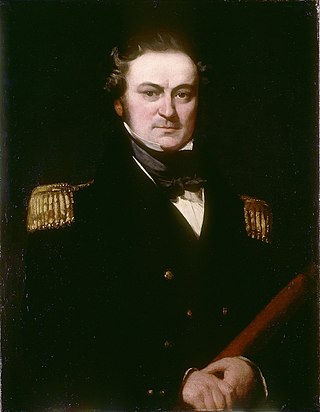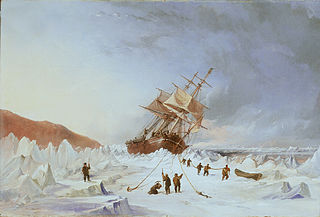
Sir William Edward Parry was an Royal Navy officer and explorer best known for his 1819–1820 expedition through the Parry Channel, probably the most successful in the long quest for the Northwest Passage, until it was finally negotiated by Roald Amundsen in 1906. In 1827, Parry attempted one of the earliest expeditions to the North Pole. He reached 82° 45' N, setting a record for human exploration Farthest North that stood for nearly five decades before being surpassed at 83° 20' N by Albert Hastings Markham in 1875.

Sir John Ross was a Scottish Royal Navy officer and polar explorer. He was the uncle of Sir James Clark Ross, who explored the Arctic with him, and later led expeditions to Antarctica.

Sir John Franklin was a British Royal Navy officer and Arctic explorer. After serving in wars against Napoleonic France and the United States, he led two expeditions into the Canadian Arctic and through the islands of the Arctic Archipelago, in 1819 and 1825, and served as Lieutenant-Governor of Van Diemen's Land from 1839 to 1843. During his third and final expedition, an attempt to traverse the Northwest Passage in 1845, Franklin's ships became icebound off King William Island in what is now Nunavut, where he died in June 1847. The icebound ships were abandoned ten months later and the entire crew died, from causes such as starvation, hypothermia, and scurvy.

HMS Hecla was a Royal Navy Hecla-class bomb vessel launched in 1815. Like many other bomb vessels, she was named for a volcano, in this case Hekla in southern Iceland. She served at the Bombardment of Algiers in 1816. Subsequently, she took part in three expeditions to the Arctic. She then served as a survey vessel on the coast of West Africa until she was sold in 1831. She became a merchantman and in 1834 a Greenland whaler. She was wrecked in 1840.
HMS Heron was originally the merchant vessel Jason, launched at Newcastle in 1803, that the Admiralty purchased in 1804 for the Royal Navy for use as 16-gun ship-sloop under the name HMS Heron. During the Napoleonic Wars she served as a convoy escort on the Leeward Islands station. Then in 1810 the Admiralty had her converted into a bomb vessel and renamed her HMS Volcano. As Volcano she served during the War of 1812, and in particular participated in the Battle of Baltimore. The Admiralty sold her in 1816. New owners returned her to mercantile service under her original name of Jason. She was wrecked in 1821.

HMS Griper was a Bold-class gun-brig of the British Royal Navy, built in 1813 by Mark Williams and John Davidson at Hythe. She participated in the 1819 expedition to the Arctic led by William Parry, made a voyage to Greenland and Norway in 1823, and took part in Parry's third expedition in 1824 as a support ship. Her crew in 1819, 1823, or 1824, qualified for the "Arctic Medal", which the Admiralty issued in 1857. She was eventually broken up in 1868.

HMS Meteor was a bomb vessel of the Royal Navy. She was previously the West Indiaman Sarah Ann, launched at Newcastle upon Tyne in 1800 that the Admiralty purchased in October 1803. She conducted bombardments at Havre de Grâce, the Dardanelles, and Rosas Bay, on the Spanish coast. She was sold in 1811. she then returned to mercantile service under her original name, Sarah Ann. She continued to trade, primarily across the North Atlantic. She was last listed in 1863 with stale data.
Captain Henry Parkyns Hoppner was an officer of the Royal Navy, Arctic explorer, draughtsman and artist. His career included two ill-fated voyages culminating in the loss of HMS Alceste in 1816 and HMS Fury in 1825.

HMS Assistance was an Arctic discovery barque of the Royal Navy, and the sixth vessel to carry the name. She began in 1834 as the India-built merchant vessel Acorn. Her name was changed to Baboo. Under that name she transported contract labourers between Mauritius and India, and immigrants to South Australia. The Royal Navy purchased her in 1850 and named her HMS Assistance. Assistance participated in two Arctic expeditions before her crew abandoned her in the ice in 1854.
Paragon was launched at Whitby in 1800. Between 1803 and 1805 she served as an armed defense ship protecting Britain's coasts and convoys. She then served as a transport on the 1805 naval expedition to capture the Cape of Good Hope. Next, she returned to mercantile service and in 1814 a French privateer captured her, but the British Royal Navy recaptured her the next day. She sailed to India in 1818 under a license from the British East India Company (EIC), and was wrecked in March 1819 while inbound to Calcutta.
Cumberland was launched at Holyhead in 1826 as a steam packet. In 1839 she underwent conversion to a sail barque. In 1846 Cumberland transported Parkhurst apprentices to the Swan River Colony. She foundered on 23 October 1849 while carrying rice from Bally, Netherlands East Indies, to Hong Kong.
Harpooner was launched at Whitby in 1769, or possibly a few years later. Her early career is obscure. She may have been a Greenland whaler between 1786 and 1792. She appeared in Lloyd's Register in 1801, and thereafter traded across the Atlantic. She was wrecked in 1816 with heavy loss of life.
Glenmore was launched in 1806 at Elgin. She was initially a West Indiaman. She made one voyage to Bengal in 1813–14. She became a Greenland whaler in 1818 and made four full whaling voyages. She was lost in the White Sea in 1822.
Earl Fauconberg was launched at Whitby in 1765. From 1784 on she made numerous voyages as a Greenland whaler. She was lost there in 1821.
Harriet was launched at Pictou, Nova Scotia, in 1798. She was the first large ship built in Nova Scotia and was sold in London. She traded widely from London, primarily to North America. She foundered on 3 November 1818.
Albion Packet was a schooner launched at Berwick by Gowan. She sailed primarily along Britain's coasts, and later to the Baltic. She disappeared from the registers between 1816 and 1822, when she reappeared as Albion. Circa 1827 she became Albion Packet again. She underwent two maritime mishaps, one in August 1802 and one circa December 1827, before being wrecked on 17 November 1832 near Orford High Light.

Isabella was launched in Kingston upon Hull in 1813. She initially sailed as a transport, and then as a merchantman trading with Canada. In 1817 the British Admiralty hired her as one of two vessels that would go on an expedition to search for a Northwest Passage. The expedition was unsuccessful. In 1820 she underwent two maritime mishaps, only one of which was substantive. From 1824 until she wrecked in the ice in June 1835 she was a whaler in the northern whale fishery.
Gibraltar was launched in 1776 in France, almost certainly under another name. Between 1787 and 1795, she was a whaler in the northern whale (Greenland) fishery. A French privateer captured her in February 1796 as she was on her way to the fishery, and burnt her. Her loss led the British government to increase the protection of the outward-bound whaling fleet.
Achilles was built at Sunderland in 1799. Although early on she made some voyages to the West Indies, she spent most of her mercantile career trading with the Baltic and northern Russia, and as a coaster. However, between about 1810 and 1814, she served as a transport under Transport Board. She suffered three maritime mishaps before 1835 and assisted at a fourth. She was lengthened in 1835. Her crew abandoned her in October 1839 and she subsequently foundered.
Mentor was launched in 1792 at Wemyss. With the out break of war with France in early 1793, the Royal Navy needed smaller vessels to protect convoys from privateers. The Navy employed Mentor as a hired armed vessel, releasing her from her contract at the end of 1801 after the signing of the Treaty of Amiens. She then returned to mercantile service, sailing first to Hamburg and then Oporto. She became a coaster on England's east coast, or a Baltic trader. She was last listed in 1832.







